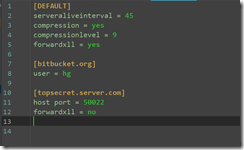一、日志模块(logging )
日志是一种追踪软件运行时所发生事件的方法
1、简单的日志编写(文件输出)
import logging # 日志模块 # 日志配置,把日志内容存到文件中 logging.basicConfig(level=logging.ERROR, # 级别修改,注意一定是大写 format='%(asctime)s %(filename)s[line:%(lineno)d] %(levelname)s %(message)s', datefmt='%a, %d %b %Y %H:%M:S', # 指定时间格式 filename='test.log', # 日志内容存到该文件目录下 filemode='w') # 模式,每次开始都刷新重写,如果想要之前的内容就把‘w’改为‘a’ # 日志级别,()里面是日志的内容,可以随意添加 logging.debug('debug message') logging.info('info message') logging.warning('warning message') logging.error('error message') logging.critical('critical message')
输出:Tue, 05 Mar 2019 16:37:S logging .py[line:16] ERROR error message
Tue, 05 Mar 2019 16:37:S logging .py[line:17] CRITICAL critical message2、文件和屏幕同时输出
import logging logger = logging.getLogger() # 创建一个hangler, 用于写入日志文件 fh = logging.FileHandler('test.log') # 文件输出对象 # 再创建一个handler, 用于输出到控制台 ch = logging.StreamHandler() # 屏幕输出对象 formatter = logging.Formatter('%(asctime)s - %(name)s - %(levelname)s - %(message)s') fh.setFormatter(formatter) # 文件输出创建一个formatter输出流格式 ch.setFormatter(formatter) logger.addHandler(fh) # logger里面有两种输出对象,文件和屏幕 logger.addHandler(ch) logger.setLevel(logging.WARNING) # 修改输出日志的级别,从DEBUG开始,输出5行,注意全是大写
# 日志等级是从上到下依次升高的,即:DEBUG < INFO < WARNING < ERROR < CRITICAL logging.debug('debug message') logging.info('info message') logging.warning('waring message') logging.error('error message') logging.critical('critical message')
二、os模块
作用:对大量的文件和文件路径进行操作
import os print(os.getcwd()) # 获取当前工作目录 os.chdir(r'F:My testfullstackweek2') # 改变当前工作目录,加r表示原生字符串,不进行任何转义 print(os.curdir) # 获取当前目录:‘.’ 用一个‘.’ 表示 print(os.pardir) # 获取当前目录的父级目录字符串名:‘..’ os.makedirs('abc') # 创建文件夹,默认创建在当前目录下,如果文件已存在,报错 os.makedirs('abc\long') # 创建多层目录,用 \ 隔开 os.mkdir('abc') # 只能生成一个文件 os.mkdir('abc\long') # 在已经有abc 文件的基础上,再生成一个文件loing os.removedirs('abc\long') # 删除文件夹(只能删除空文件)先判断long中有没有文件,没有就删除,一层层往外找 os.rmdir('abc') # 删除单级空目录,若目录不为空无法删除 dirs = os.listdir(r'F:My testfullstackweek2') # 打印绝对目录里面的所有文件 print(dirs) os.remove('abc\dff') # 删除dff文件,只能删除文件不能删除文件夹, os.rename('abc', 'www') # 修改文件(夹)名, abc改为www info = os.stat('.\www') # 获取文件的详细信息 print(info) print(info.st_size) # 获取文件大小 print(os.sep) # 获取当前系统的路径分割符 q = os.sep # 用q替换分隔符, q是一个变量 # windows里换行符为: linux里换行符为: print(os.pathsep) # 输出用于路径分割文件路径的字符 print(os.name) # 输出字符串当前使用平台 win->'nt' print(os.system("dir")) # 显示当前目录的内容 print(os.environ) # 获取系统环境变量 print(os.path.abspath('./www')) # 获取文件www的绝对路径 s = os.path.split(r'F:My testfullstackweek2day3www') print(s) # 把文件路径和文件名分隔开 s = os.path.dirname('F:\My test\fullstack\week2\day3') print(s) # 返回当前文件上一级的文件夹路径 s = os.path.basename('F:\My test\fullstack\week2\day3') print(s) # day3 返回文件名,就是 os.path.split(path) 的第二个内容 s = os.path.exists('F:\My test\fullstack\week2\day3') print(s) # path存在返回True,不存在返回False s = os.path.isabs('F:\My test\fullstack\week2\day3') print(s) # 如果path是绝对路径返回True,否则返回False s = os.path.isfile('F:\My test\fullstack\week2\day3') print(s) # 如果path是一个存在的文件返回True,否则返回False s = os.path.isdir('F:\My test\fullstack\week2\day3') print(s) # 如果path是一个存在的目录返回True,否则返回False s = os.path.join('F:\My test\fullstack\week2\day3', 'F:\My test\fullstack\week2\day4') print(s) # 路径拼接: F:My testfullstackweek2day4 s = os.path.getatime('F:\My test\fullstack\week2\day3') print(s) # 返回path所指向文件或目录的最后存取时间 s = os.path.getmtime('F:\My test\fullstack\week2\day3') print(s) # 返回path所指向文件或目录的最后修改时间
三、configparser 模块
作用:用于生成和修改常见的配置文件,通过字典录入
import configparser # 所有操作都围绕config对象进行 config = configparser.ConfigParser() # 写入文件 config["DEFAULT"] = {'ServerAliveInterval': '45', 'Compression': 'yes', 'CompressionLevel': '9'} # 生成的是字典的形式:DEFAULG 是键,中括号里面是键值,下同 config['bitbucket.org'] = {'User': 'hg'} config['topsecret.server.com'] = {} topsecret = config['topsecret.server.com'] topsecret['Host Port'] = '50022' topsecret['ForwardXll'] = 'no' config['DEFAULT']['ForwardXll'] = 'yes' with open('example.ini', 'w') as configfile: config.write(configfile)
输出:
写入的文件还可以读出来:
import configparser config = configparser.ConfigParser() # 所有操作都围绕config对象进行 config.read('example.ini') # 读配置文件操作 print(config.sections()) # 不能读取默认块儿的内容:['bitbucket.org', 'topsecret.server.com'] print(config.defaults()) # 读取默认块儿DEFAULT里面的信息 print(config['bitbucket.org']['User']) # hg for key in config: print(key) # 打印所有块儿的名字 for key in config['bitbucket.org']: print(key) # DEFAULT 是特殊的,打印别的块下的内容它也跟在下面
配置文件的增删改:
config.remove_section('topsecret.server.com') # 删除块:topsecret.server.com config.write(open('i.cfg', 'w')) # 无论如何修改都要加这句,下同 print(config.has_section('topsecret.server.com')) # 判断有没有该字符串:False (因为前面删除了) config.set('bitbucket.org', 'user', 'xiaoss') # 修改操作:('块', '键', '要修改的值') config.remove_option('DEFAULT', 'forwardxll') # 删除块下的某个键值对儿:('块', '键值') config.write(open('example.ini', 'w')) # 注意对文件example.ini,是完全清空重新写入,是覆盖,文件名与原来相同
注意:一个文件一旦命名绝对不会被修改,只能重新建立文件写入,修改并不是真正的修改,而是建立新的文件放在对象里面然后覆
盖原来的对象



